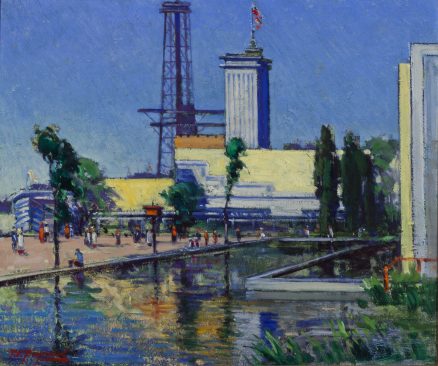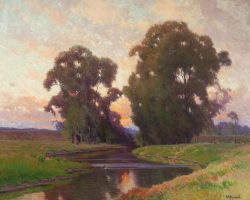Afternoon, The Science Palace, World’s Fair, 1933
, 1933Oil on canvas, 20 by 24 inches
- Zoom in on Artwork
- Print Page
- Email Page to Friend
Frank Peyraud’s painting shows the Hall of Science at Chicago’s Century of Progress Exposition of 1933-1934. In contrast to Rudolph Ingerle’s Untitled (Hall of Science at Night), a nighttime view of the building’s north entrance, Peyraud pictured the structure from the south in the full light of afternoon, under a cloudless sky. Designed by Paul Philippe Cret, the Hall of Science was filled with wondrous displays of modern discoveries and innovations, of which Peyraud gives little hint. In his portrayal the building’s blocky form is softened by intervening trees and the bright colors of its exterior are relatively subdued, notwithstanding their echo in the broad reflecting pool in the foreground. Crowning the scene is the Carillon Tower, a 176-foot-high glass-and-steel structure from which music was played both day and night. Inspired by European modernist design, its irregular form contrasted vertical and horizontal elements, a heavy flat roof on the main section with a soaring spire on the northeast corner enlivened with colorful flags, as seen here. Just behind rises one of the two steel skeleton towers of the Sky Ride, among the exposition’s most popular attractions. A complex web of cables supported the “rocket cars” that provided a “beautiful and, mayhap, thrilling ride” to the far side of the lagoon at the heart of the fairgrounds.i Clearly visible in photographic views of the Hall of Science from the south, the cables are absent in Peyraud’s view, in which the Sky Ride tower itself is a relatively shadowy presence in the background.
By 1933 Peyraud was nearing the end of his career as a successful painter of bucolic landscapes such as Summer Evening. The Century of Progress exposition represented a departure from his usual subjects. Yet it also drew on his earliest professional training—as an architect—and his first significant painting experience—as a contributor to cycloramas, enormous paintings-in-the-round that called for skills in perspective and in the composition of large-scale scenes. Afternoon, The Science Palace, World’s Fair also conformed to Peyraud’s long-practiced style, a conservative brand of impressionism that combined broken brushwork with a concern for structured composition and firmly defined forms.
Afternoon, The Science Palace, World’s Fair is one of a group of images of the Century of Progress exposition created by artists working under the name Groh Associates. Their paintings of the fair, which also included Otto Koch’s Electrical Entrance, were intended to record the brilliant color and advanced lighting technologies that were among the most striking features of the exposition. Peyraud’s canvas may have been among the group when it was exhibited at the Marshall Field and Company department store in Chicago during the 1934 fair season.
Wendy Greenhouse, PhD
Donated by M. Christine Schwartz to the Newberry Library, Chicago, Illinois, in 2021
i Official Guide: Book of the Fair 1933 (Chicago: A Century of Progress Administration Buildings, [1933]), 121.

